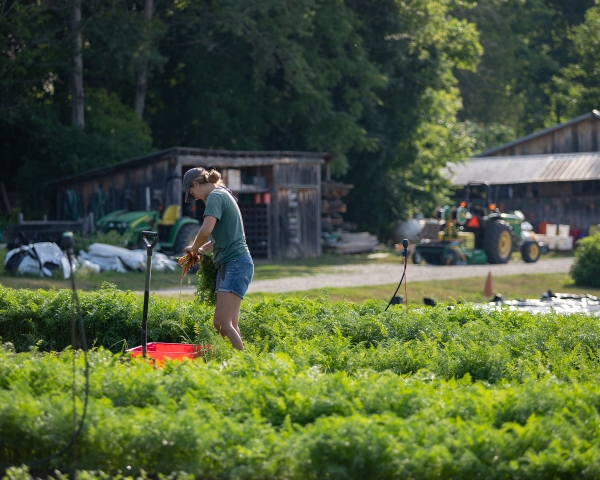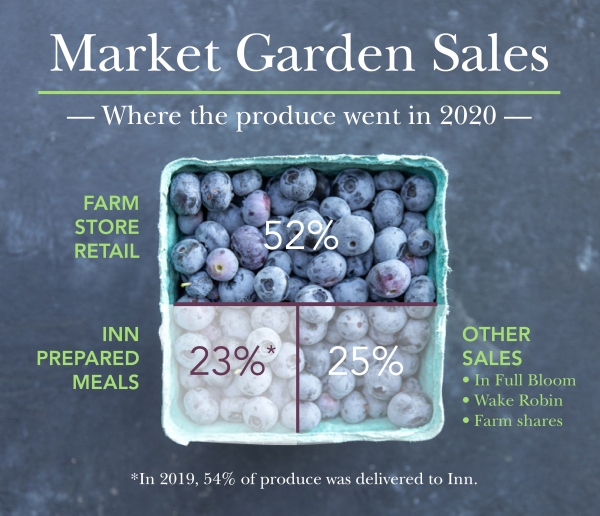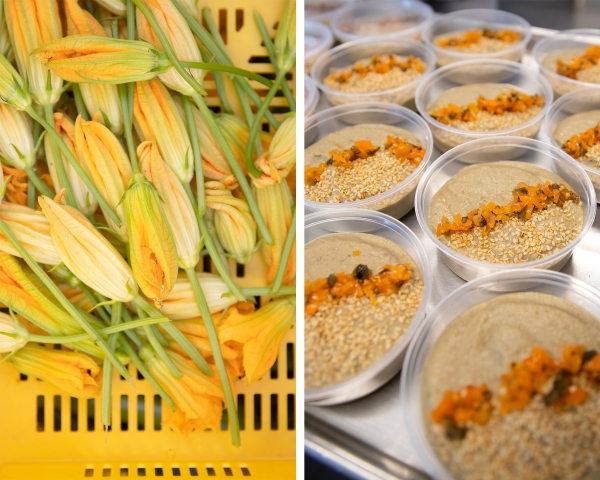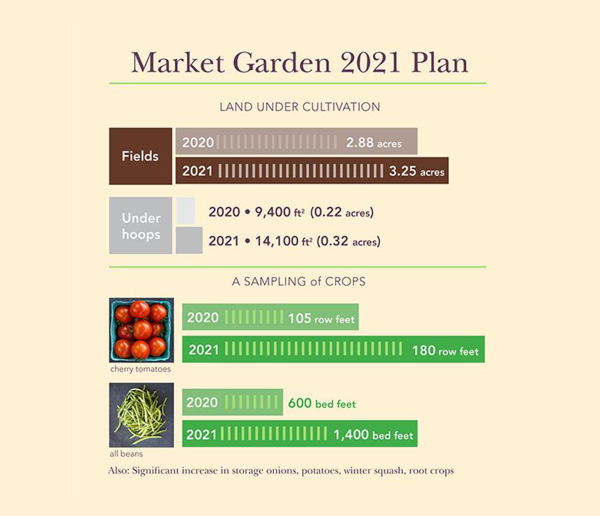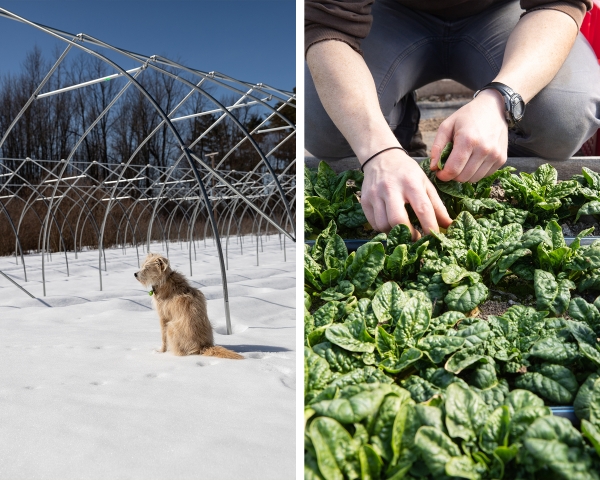Love the new ideas for the garden produce. Makes a lot of sense.
On the other hand, I was very disappointed you canceled the summer camps. My grandson was so looking forward to it!
From Field to Curbside: 2021 Market Garden Plans
In the Northeast, we’re dreaming of gardening… What new varieties will we plant? What worked last year? What do we want to do differently? All of that prepping, planning, and spring energy is afoot in our seven-acre, organic Market Garden, too — but on a much bigger scale, and with a new lens.
When March 2020 hit and the pandemic closed the doors to the Inn’s beloved dining space, quick changes were made to best reroute the harvest that had been destined for the dining room to be used in retail and packaged foods. Now, with a better sense of the coming year, the Market Garden Team has had the chance to step back and learn from the last twelve months.
While our garden plans are never a cut-and-paste from the previous year, “The changes we made this year are the biggest changes we’ve made in about twelve years, when we built the education pavilion,” shares Market Garden Manager Josh Carter. Building on key successes from 2020 — providing our local community with both fresh produce and prepared foods at the Farm Store & Welcome Center — three pivots are taking root in the Market Garden:
Listening to our Community
In 2020, over 50% of the total value of produce harvested from the Market Garden was sold directly through the Farm Store & Welcome Center as fresh vegetables and fruits. It’s a success we will be building on this year. “We’re here for the community, so we have to hear what the community wants and figure out how we can best serve them,” explains Chef John Patterson, another integral voice in garden planning. “The things we sell at the Farm Store and Welcome Center need to be relatable,” John says.
To that end, more field and tunnel space is being dedicated to more traditional crops this year. “We’re growing more of the things that people like to buy and cook at home: beans, potatoes, tomatoes, cucumbers, and tomatoes,” Josh says.
“And if some of the things we’re growing for the kitchen become big hits in the Farm Store to buy as fresh produce,” John adds, “then I can work with local producers to purchase their harvest for use in the kitchen.”
“For the 2020 growing season,” John continues, “I had requested a lot of very cool and unique vegetables. Once COVID hit, those were cut from the program due mainly to staff capacity. Vegetables like celtuce. You have to peel it forever for it to be usable, but it’s great pickled, and when it’s grilled it has this amazing hazelnut flavor. The leaves almost look like giant Romaine leaves, but with a bitterness. Since most people don’t want to buy it, it wasn’t worth the resources to grow it throughout the season.”
Plan for the Packaged Meal, not the Plated Meal
Our Market Garden plans are typically optimized for supplying its biggest client: the Inn Restaurant. But while a fine dining experience is meticulously planned and controlled, heat-and-eat meals are a whole other story with different ingredient requirements.
As we’ve probably all learned in our takeout journey this year, not everything can be put in a paper clamshell, survive the bumpy road home in the passenger seat, or withstand a few days in the back of the fridge. “This year, we’re growing a lot less microgreens and specialty greens that restaurants love for salads and plating—like bitter greens, endive, escarole, chrysanthemum greens,” Josh says. “These garnishes really show the beauty and the energy of the place,” John further explains. “We’d usually have trays of these delicate greens and cut sprouts to order. In your typical restaurant, you’d never get greens that fresh! But in a packaged food program those flourishes don't make sense. Those were the first crops to cut.”
Eggplants are a different story. “We’re planting more eggplant this year because they worked well for the prepared foods model — remember that baba ganoush?” Josh shares. “So we need to think about what eggplant is good for cooking these recipes. We’ll be doubling the amount of the traditional Italian varieties because they offer the most meat. Josh and John also found a specific squash variety that is known for its large, plentiful flowers – the key ingredient in our squash blossom fettuccine.
Extending the Growing Season
Another element of being a reliable source of healthy foods is to offer them throughout as much of the year as possible — and a lot of changes have been made in the Market Garden to make that a reality. We're not farming the land harder — Josh is dedicated to nurturing healthy soil as much as healthy crops — but we are cultivating more land, and bringing more land under the cover of tunnels.
“At this point, we’re growing close to year-round.” Josh explains. “We’re prepping beds in early March. Previously, we didn’t have an outlet for this early produce because the Inn didn’t open until mid-May. Now if I have arugula in April, we have the infrastructure to sell it at the Farm Store & Welcome Center.“ Infrastructure improvements include coolers for keeping things fresh at the Farm Store and Market Garden post-harvest, as well as additional space for storage crops, which have outgrown their current, makeshift space inside the sugarhouse.
“On the other end of the calendar,” Josh continues, “we never wanted anything to come out of the field any later than mid-September — minus a few things like Brussels sprouts and kale that are nice to keep in the ground later — because the Inn’s season would be drawing to an end. But now we’re growing fall crops and harvesting into as late as November.”
After such a tiring past year, this growing season might give us the lift we need: tiny sprouts elbowing their way up through the ground, sunlight glowing through a row of greens, the scent of warm rain on soil. We’re excited to catch that energy and continue to expand and evolve our food offerings to our community at the Farm Store & Welcome Center. “Before 2020, we had a bunch of different components to our food program,” John recalls. “Now the Farm Store has unified them: there's something for everyone when they arrive on the Farm."
Comments
Thank you for the update, Sarah.
Since I work via Telehealth about half time, there are days when I have no time to cook. So we have picked up a variety of meals (plus more food) at the Farm. They are: delicious, healthful, and such a help.
Kay Frances Schepp
That is so wonderful to hear - the prepared meals are such a timesaver for me, too. Thank you for sharing!

